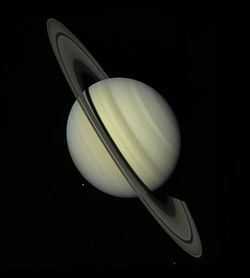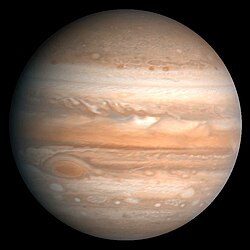Pioneer 11
 Pioneer 11 | |
| Status | Inaktiv |
|---|---|
| Typ | Förbiflygare |
| Program | Pioneerprogrammet |
| Organisation | NASA |
| NSSDC-ID | 1973-019A[1] |
| Uppdragets varaktighet | Till november 1995 |
| Sista kontakt | 30 september 1995 |
| Uppskjutning | |
| Uppskjutningsplats | Cape Canaveral LC-36B |
| Uppskjutning | 6 april 1973, 02:11 UTC |
| Uppskjutningsfarkost | Atlas/Centaur/TE364-4 |
| Förbiflygning av Jupiter | |
| Datum | 3 december 1974 |
| Minsta avstånd | 43 000 km |
| Förbiflygning av Saturnus | |
| Datum | 1 september 1979 |
| Minsta avstånd | 21 000 km |
| Egenskaper | |
| Massa | 259 kg |
| Effekt | 165 W |
Pioneer 11 är en rymdsond som inom Pioneerprogrammet sändes ut i rymden 1973 för att utforska planeterna Jupiter och Saturnus. Man förlorade kontakten med Pioneer 11 i november 1995. Sonden befann sig då 44,7 AE från solen och var i rörelse mot de yttre delarna av solsystemet med en hastighet av ungefär 2,5 AE per år.
Se även
Källor
- ”The Pioneer Missions” (på engelska). NASA. https://www.nasa.gov/centers/ames/missions/archive/pioneer.html.
- ^ ”NASA Space Science Data Coordinated Archive” (på engelska). NASA. https://nssdc.gsfc.nasa.gov/nmc/spacecraft/display.action?id=1973-019A. Läst 26 mars 2020.
Externa länkar
 Wikimedia Commons har media som rör Pioneer 11.
Wikimedia Commons har media som rör Pioneer 11.
| ||||||||||||||||
| |||||||||||||||||||||||||||||||||||||||||||||||||
| ||||||||||||||||||||||||||||
Media som används på denna webbplats
Pioneer 10 and Pioneer 11
NASA's Voyager 1 took this photograph of Saturn on Oct. 18, 1980, 34 million kilometers (21.1 million miles) from the planet. The photograph was taken on the last day that Saturn and its rings could be captured within a single narrow-angle camera frame as the spacecraft closed in on the planet for its nearest approach on Nov. 12. Dione, one of Saturn's inner satellites, appears as three color spots just below the planet's south pole. An abundance of previously unseen detail is apparent in the rings. For example, a gap in the dark, innermost ring, called the C-ring or crepe ring, is clearly shown. Material is seen within the relatively wide Cassini Division, separating the middle, B-ring from the outermost ring, the A-ring. The Encke Division is shown near the outer edge of the A-ring. The detail in the rings' shadows cast on the planet is of particular interest: the broad, dark band near the equator is the shadow of the B-ring; the thinner, brighter line is just to the south of the shadow of the less dense A-ring.
Original Caption Released with Image: This processed color image of Jupiter was produced in 1990 by the U.S. Geological Survey from a Voyager 2 image captured in 1979. The colors have been enhanced to bring out detail. Zones of light-colored, ascending clouds alternate with bands of dark, descending clouds. The clouds travel around the planet in alternating eastward and westward belts at speeds of up to 540 kilometers per hour. Tremendous storms as big as Earthly continents surge around the planet. The Great Red Spot (oval shape toward the lower-left) is an enormous anticyclonic storm that drifts along its belt, eventually circling the entire planet.
(c) 7Train at the English Wikipedia, CC BY-SA 3.0
This file is completely inaccurate and should be deleted. See this discussion: https://space.stackexchange.com/a/48082 Produced with Adobe Illustrator CS4. 7/2/07.








